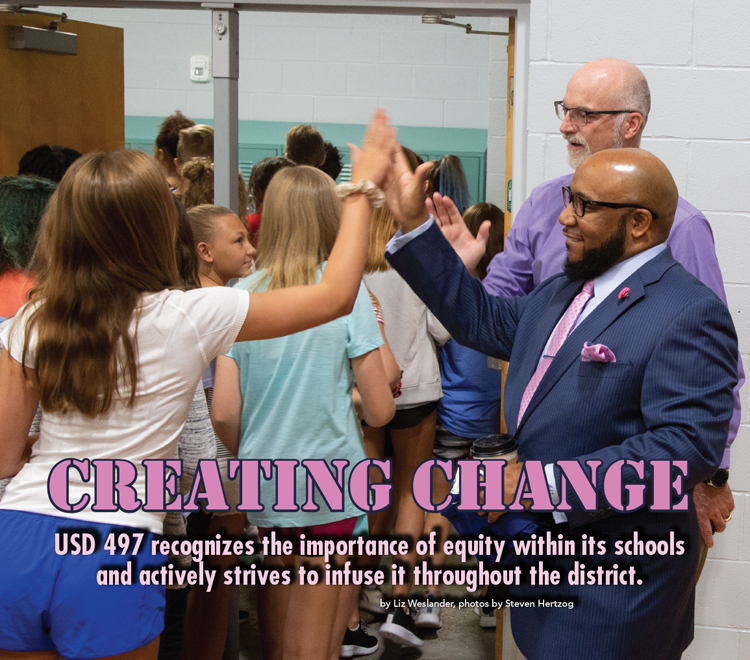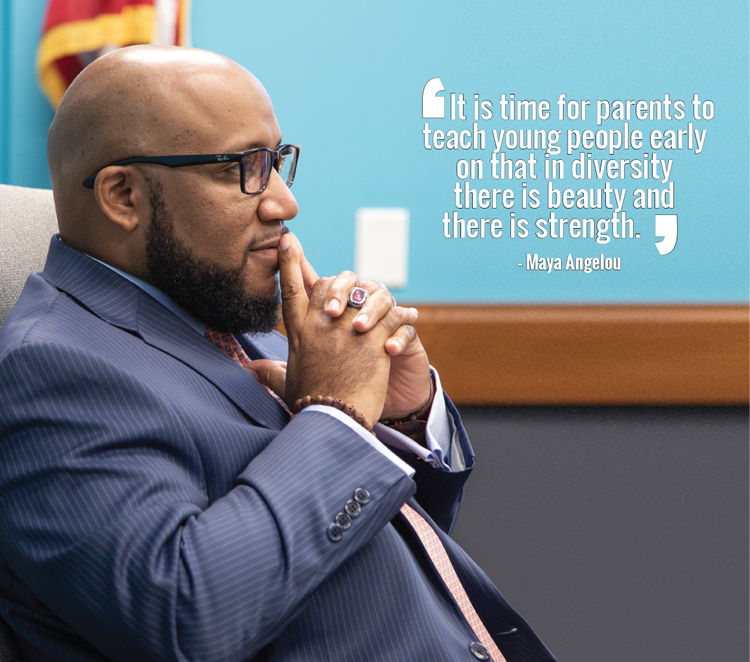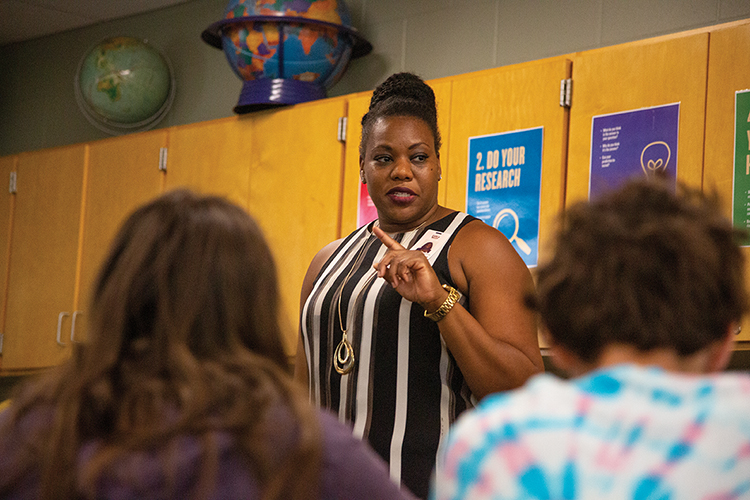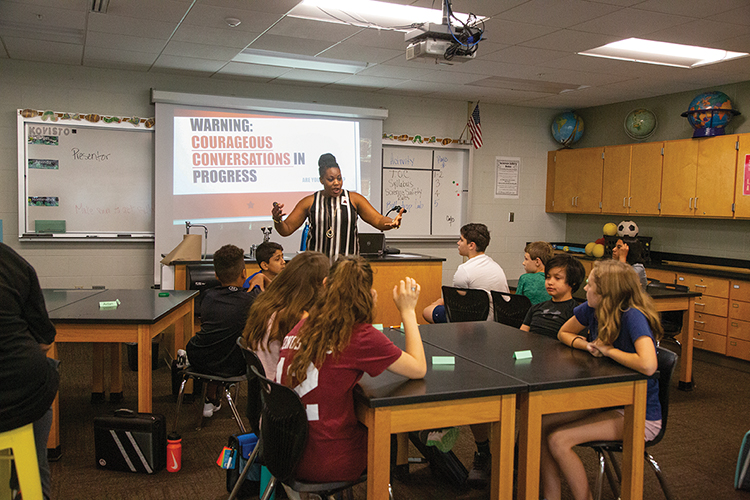USD 497 recognizes the importance of equity within its schools and actively strives to infuse it throughout the district.
| 2019 Q3 | story by Liz Weslander | photos by Steven Hertzog

Superintendent Dr. Anthony Lewis and Director of Secondary Schools Rick Henry, greet students back to school at Southwest Middle
With this mission in mind, the district has had equity training for staff in place since 2009 and, in 2012, appointed Danica Moore as equity facilitator to further support the district’s equity training and goals.
In 2018, the district, tasked with hiring a new superintendent who “possesses the leadership skills required to respond to the challenges presented by an ethnically and culturally diverse community,” chose Anthony Lewis, a former assistant superintendent in the Kansas City, Missouri, district with a track record of positive outcomes in schools he has served. Lewis aims to be a transformational leader for USD 497, which includes a focus on achieving meaningful results in the area of equity.
But what does equity really mean? In order to provide clarity, both Lewis and Moore compare the concept of equity to other commonly heard buzzwords in the world of education. Superintendent Lewis says it is important to distinguish between equality, which focuses on allocating resources equally regardless of need, and equity, which focuses on varying the allocation of resources to individual schools, classrooms and students based on data showing what they need to be successful.
“As a leader, I see schools and school districts that operate on the premise of equality, meaning that they want every school to have the same thing just because that’s what is fair,” Lewis explains. “But if we are really serious about responding to the needs of the students, we need to look at things through an equity lens. We have very diverse schools in this district, and there are some that are outperforming each other. They will continue to outperform each other unless we make decisions from an equity standpoint.”
For equity facilitator Moore, it is also important to understand the difference between equity and diversity.
“For the longest time, our country has had a culture of celebrating diversity, but then it just stops there,” Moore says. “Diversity is a baseline. It’s the idea that everyone is welcome. Diversity is numbers and representation at the table. But equity is saying when people are at the table, are they getting what they need? To have diversity and inclusion, but not equity, means that someone is still suffering.”

School Superintendent Dr. Anthony Lewis listens intently at the bi-monthly USD 497 board of directors meeting
Diversity in Leadership
Lewis, now in his second year as superintendent for USD 497, grew up in Alabama and spent the first 10 years of his career working there as a special education teacher, assistant principal and principal. In 2011, the Kansas City, Missouri, school district recruited him to serve as principal of Benjamin Banneker Elementary School. He was soon promoted to director of elementary education for the district and, in 2016, advanced to assistant superintendent. Lewis says his move to Lawrence in 2018 has been a great experience so far.
“I tell people that Lawrence is the world’s best-kept secret,” Lewis says. “It’s really a diverse and accepting community, and has been so welcoming to me and my family.”
Lewis says growing up as an African American student in a predominantly white school district meant there were times when he missed out on opportunities afforded to other students. This experience allows him to be more aware of what students of color in USD 497 might be experiencing, he says, and helps keep inclusion at the forefront of his actions. Having people of color such as himself in district leadership positions can be inspiring for students of color, he adds.
“When they would introduce me to classrooms during my first year here, my eyes would naturally go to the students of color in the room, and I could see them just light up,” Lewis says. “It’s important for diverse students to see someone who looks like them in a leadership role. They start to see that what they may have thought was impossible is actually possible.”
Because collaboration is an important part of his leadership philosophy, Lewis spent much of his first year in USD 497 doing a listening and learning tour that included six public-input sessions held across the community that attracted nearly 500 attendees. The district also collected more than 790 online feedback forms as part of the tour.

Danica Moore leads discussions with 7th grade class at Billy Mills Middle School
“I was very intentional in my first year about listening and learning,” Lewis says. “Sometimes new leadership will come in and want to immediately change things, but I thought it was valuable to come in and really learn the lay of the land and learn the needs of the community. I really wanted to hear from parents, teachers and students about their experiences.”
One of the biggest takeaways he took from the yearlong listening tour is that the community is ready to see achievement gaps in the district shrink, Lewis says. The community is also concerned about data that shows a disproportionate number of minority students are suspended at higher rates in the district.
Lewis’s year of listening and gathering data has since been transformed into a five-year strategic plan. He says when creating the plan, he wanted to avoid having equity as a separate category and therefore worked to create a plan that has equity woven throughout.
“Equity is not measured in numbers of trainings we receive or in the books we read. Equity is measured in the changes in practices and behaviors in the classroom,” he explains. “Equity should be woven into each of our action steps, and we should be able see that in every single classroom.”
Two notable equity-related goals of the district’s new five-year plan are collaborating with community organizations like LMH Health and the City of Lawrence on equity efforts and focusing on selecting evidence-based, multicultural instructional resources that honor and preserve students’ diverse cultural backgrounds.
Lewis also notes the district is working on removing institutional and financial barriers to college-prep courses at the high school level.
“The only way that we can close achievement gaps is to first focus on opportunity gaps and making sure that students of color and low socioeconomic status have the opportunity to be part of advanced placement and concurrent college classes.”

Danica Moore leads discussions with 7th grade class at Billy Mills Middle School
Equity Foundations
While Superintendent Lewis has identified some fresh ways to address equity in the district, for the last seven years, USD 497’s equity facilitator Moore has been building a foundation and creating an environment where staff and students can effectively discuss and address how race and equity overlap.
One of Moore’s regular tasks has been coordinating and facilitating Beyond Diversity workshops for staff across the district. Beyond Diversity, a training developed by district consultant Pacific Educational Group, is a foundational two-day seminar designed to help educational communities understand the impact of race on student learning and investigate the role that racism plays in institutionalizing academic achievement disparities.
Beyond Diversity training focuses on teaching participants a specific protocol called Courageous Conversations that helps people analyze and reflect on the impacts of race with the idea that they will take this protocol into the workplace and classrooms, and use it to analyze and reflect on situations in a way that is conscious of race. Beyond Diversity training is required for everyone who works for the district.
Lewis says the Courageous Conversations trainings Moore has been leading are an important component of positive change for the district and society.
“If we want to change generational racism and misunderstanding of different cultures, it starts with our students and teaching them to have conversations about these things,” he says. “We don’t want teachers to sweep stuff under the rug when there is an opportunity there to address it, which means we need make sure that our educators are equipped with the skills to have those conversations, as well.”
Another initiative Moore has worked on during her time as equity facilitator is creating a support group for staff of color in the district. Moore explains that when she went to her induction after first being hired by USD 497 as a special education teacher, she remembers noticing that she was the only black or brown face in the room. As Moore built relationships with other staff of color across the district, she learned they’d had similar experiences and were interested in having a space to connect with other people of color in the district. She says this kind of support group is especially relevant given the equity work that is occurring regularly in the district.
“Equity work is taxing, and equity work taxes those who are in the marginalized populations the most because it is working within their very identities,” Moore says. “When discussions on race come up, and a staff member of color is the one person that people are looking to on that subject, there can be fatigue in that, as well. Making sure that staff of color still have the support that they need is critical.”
Moore also explains this type of support is an important component of retaining staff of color.
“Committed and effective staff need to be mentally and emotionally healthy,” she says. “Keeping staff of color effective means providing them with a space where they can hash out the day-to-day experiences in the schools. When they can unpack that and go home mentally and emotionally decompressed, it keeps them healthier in a mental and emotional capacity.”
In her role, Moore has spent time in all the district’s schools working with teachers and students in classrooms. While in the district’s different buildings, she started noticing some patterns of interactions that involved indirect, subtle or even unintentional discrimination against members of a marginalized group—otherwise known as microaggressions. Based on these experiences, she developed a foundational microaggression training for the district that outlines four categories of microaggressions to help staff further examine the topic. The categories are microassaults, microinsults, microexclusions and microinvalidations.
“I picked the categories based on what I had seen occurring in the buildings between adults, between students and between adults and students,” Moore explains. “The training is really just a learning space for staff, because for many people in those trainings, it is the first time they have heard the word microaggression. So it’s a chance to explore the word, look at examples and think about some examples they have seen now that they have the information. It’s a chance to reflect and ask questions.”
Moore admits both the Beyond Diversity and microaggression trainings can be emotionally challenging for people, and reactions to the information run the gamut from inspired to discouraged. There are equity teams in place in all the schools to help staff debrief and continue the conversations they have in trainings. Her hope is people understand that every single person in the community gains from equity.
“The perspective in the community is sometimes a sense of loss, because society has socialized people to think that equity means giving up something,” Moore says. “But equity is allowing us to bring people in and to have conversations where we all gain a sense of respect, a sense of awareness and a sense of learning. There is a 100 percent gain and 0 loss in equity.” p
